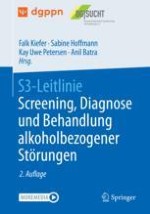2022 | OriginalPaper | Buchkapitel
2. Screening und Diagnostik von Intoxikation, riskantem, schädlichem und abhängigem Alkoholgebrauch
verfasst von : Friedrich M. Wurst, Erika Baum, Gallus Bischof, Eva Hoch, Karl Mann, Tim Neumann, Oliver Pogarell, Hans-Jürgen Rumpf, Ulrich W. Preuss, Claudia Spies, Natasha Thon, Wolfgang Weinmann, Falk Kiefer, Sabine Hoffmann
Erschienen in: S3-Leitlinie Screening, Diagnose und Behandlung alkoholbezogener Störungen
Verlag: Springer Berlin Heidelberg











